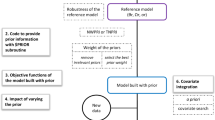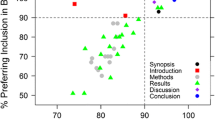Abstract
Developing the skills or expertise to create useful population pharmacokinetic-pharmacodynamic models can be a daunting task-the level of mathematical and statistical complexity is such that newcomers to the field are frequently overwhelmed. A good place to start in learning the field is to read articles in the literature. However, the number of articles dealing with population pharmacokinetic pharmacodynamics is exponentially increasing on a yearly basis, so choosing which articles to read can be difficult. The purpose of this review is to provide a recommended reading list for newcomers to the field. The list was chosen based on perceived impact of the article in the field, the quality of the article, or to highlight some important detail contained within the article. After reading the articles in the list, it is believed that the reader will have a broad overview of the field and have a sound foundation for moredetailed reading of the literature.
Similar content being viewed by others
References
Sheiner LB, Rosenberg B, Marathe V. Estimation of population characteristics of pharmacokinetic parameters from routine clinical data.J Pharmacokinet Biopharm. 1977;5:445–479.
Sheiner LB, Beal SL. Evaluation of methods for estimating population pharmacokinetic parameters. II. Biexponential model and experimental pharmacokinetic data.J Pharmacokinet Biopharm. 1981;9:635–651.
Sheiner LB, Beal SL. Evaluation of methods for estimating population pharmacokinetic parameters. III. Monoexponential model: routine pharmacokinetic data.J Pharmacokinet Biopharm. 1982;11:303–319.
Sheiner LB, Beal SL. Evaluation of methods for estimating population pharmacokinetics parameters. I. Michaelis-Menten model: routine clinical pharmacokinetic data.J Pharmacokinet Biopharm. 1980;8:553–571.
Peck CC, Beal SL, Sheiner LB, Nichols AI. Extended least squares nonlinear regression: a possible solution to the “choice of weights” problem in analysis of individual pharmacokinetic data.J Pharmacokinet Biopharm. 1984;12:545–558.
Sheiner LB, Beal SL. Pharmacokinetic parameter estimates from several least squares procedures: superiority of extended least squares.J Pharmacokinet Biopharm. 1985;13:185–201.
Vozeh S, Katz G, Steiner V, Follath F. Population pharmacokinetic parameters in patients treated with oral mexiletine.Eur J Clin Pharmacol. 1982;23:445–451.
Grasela TH, Sheiner LB. Population pharmacokinetics of procainamide from routine clinical data.Clin Pharmacokinet. 1984;9:545–554.
Grasela T, Donn SM. Neonatal population pharmacokinetics for phenobarbital derived from routine clinical data.Dev Pharmacol Ther. 1985;8:374–383.
Grasela TH, Antal EJ, Ereshefsky L, Wells BG, Evans RL Smith RB. An evaluation of population pharmacokinetics in therapeutic trials. Part II. Detection of a drug-drug interaction.Clin Pharmacol Ther. 1987;42:433–441.
Wahlby U, Jonsson EN, Karlsson MO. Comparison of stepwise covariate model building strategies in population pharmacokinetic-pharmacodynamic analysis.AAPS PharmSci. 2002;4:E27.
Maitre PO, Buhrer M, Thomson D, Stanski DR. A three-step approach combining Bayesian regression and NONMEN population analysis: application to midazolam.J Pharmacokinet Biopharm. 1991;19:377–384.
Mandema J, Verotta D, Sheiner LB. Building population pharmacokinetic-pharmacodynamic models. I. Models for covariate effects.J Pharmacokinet Biopharm. 1992;20:511–528.
Hastie TJ, Tibshirani RJ.Generalized Additive Models. New York: Chapman and Hall. 1990.
Bruno R, Vivier N, Vergniol JC, DePhillips SL, Montay G, Sheiner LB. A population model for docetaxel (Taxotere®): model building and validation.J Pharmacokinet Biopharm. 1996;24:153–172.
Karlsson MO, Sheiner LB. The importance of modeling interoccasion variability in population pharmacokinetic analyses.J Pharmacokinet Biopharm. 1993;21:735–750.
Laporte-Simitsidis S, Girard P, Mismetti P, Chabaud S, Decousus H, Boissel JP. Inter-study variability in population pharmacokinetic analysis: when and how to estimate it?.J Pharm Sci. 2000;89:155–166.
Wade JR, Beal SL, Sambol NC. Interaction between structural, statistical, and covariate models in population pharmacokinetic analysis.J Pharmacokinet Biopharm. 1994;22:165–176.
Verbeke G, Molenberghs G.Linear Mixed Models in Practice: A SAS-Oriented Approach. New York: Springer Verlag: 1997.
Wahlby U, Jonsson EN, Karlsson MO. Assessment of actual significance levels for covariate effects in NONMEM.J Pharmacokinet Pharmacodyn. 2001;28:231–252.
Wahlby U, Bouw MR, Jonsson EN, Karlsson MO. Assessment of type I error rates for statistical sub-model in NONMEM.J Pharmacokinet Pharmacodyn. 2002;29:251–269.
Stram DO, Lee JW. Variance components testing in the longitudinal mixed effects model.Biometries. 1994;50:1171–1177.
Pinheiro JC, Bates DM.Mixed-Effect Models in S and S-Plus. New York: Springer Verlag; 2000.
Aarons L, Balant LP, Mentre F, Morselli PL, Rowland M Steimer J-L, Vozeh S. Practical experience and issues in designing and performing population pharmacokinetic/pharmacodynamic studies.Eur J Clin Pharmacol. 1996;49:251–254.
Kowalski K, Hutmacher MM. Design evaluation for a population pharmacokinetic study using clinical trial simulation: a case study.Stat Med. 2001;20:75–91.
Lee PID. Design and power of a population pharmacokinetic study.Pharm Res. 2001; 18:75–82.
Green D, Duffull SB. Prospective evaluation of a D-optimal designed population pharmacokinetic study.J Pharmacokinet Pharmacodyn. 2003;30:145–161.
Duffull SB, Retout S, Mentre F. The use of simulated annealing for finding optimal population designs.Comput Methods Programs Biomed. 2002; 69:25–35.
Karlsson MO, Jonsson EN, Wiltse CG, Wade JR. Assumption testing in population pharmacokinetic models: illustrated with an analysis of moxonidine data from congestive heart failure patients.J Pharmacokinet Biopharm. 1998;26:207–246.
Bonate PL. The effect of collinearity on parameter estimates in nonlinear mixed effect models.Pharm Res. 1999;16:709–717.
Hartford A, Davidian M. Consequences of misspecifying assumptions in nonlinear mixed effects models.Comp Stat Data Anal. 2000;34:139–164.
Ette EI, Williams PJ, Kim YH, Lane JR, Liu M-J, Capparelli EV, Model appropriateness and pharmacokinetic modeling.J Clin Pharmacol. 2003;43:610–623.
Bruno R, Baille P, Retout S, Vivier N, Veyrat-Follet C Sanderlink G-J, Becker R, Antman EM. Population pharmacokinetics and pharmacodynamics of enoxaparin in unstable angina and non-ST-segment elevation myocardial infarction.Br J Clin Pharmacol. 2003;56:407–414.
Rajagopalan P, Gastonguay MR. Population pharmacokinetics of ciprofloxacin in pediatric patients.J Clin Pharmacol. 2003;43:698–710.
Holford NHG. A size standard for pharmacokinetics.Clin Pharmacokinet. 1996;30:329–332.
Grasmader K, Verwohlt PL, Kuhn K-U, Dragicevic A, von Widdern O, Zobel A, Hiemke C, Rietschel M, Maier W, Jaehde U, Rao ML. Population pharmacokinetic analysis of mirtazapine.Eur J Clin Pharmacol. 2004;60:473–480.
Beal SL, Sheiner LB. Methodology of population pharmacokinetics. In: Garrett ER, Hirtz JL, eds.Drug Fate and Metabolism: Methods and Techniques. Vol. 5 New York: Marcel Dekker, Inc; 1985;135–183.
Sheiner LB, Ludden TM. Population pharmacokinetics/ pharmacodynamics.Annu Rev Pharmacol Toxicol. 1992;32:185–209.
Tett S, Holford NHG, McLachlan AJ. Population pharmacokinetics and pharmacodynamics: an underutilized resource.Drug Inf J. 1998;32:693–710.
Davidian M, Giltinan DM.Nonlinear Models for Repeated Measures Data. New York: Chapman and Hall; 1995.
Verbeke G, Molenberghs G.Linear Mixed Models for Longitudinal Data. New York: Springer-Verlag, 2000.
US Department of Health and Human Services, Food and Drug Administration. Guidance for Industry.Population Pharmacokinetics. Washington, DC: Food and Drug Administration; 1999.
Author information
Authors and Affiliations
Corresponding author
Additional information
Published: October 5, 2005
Rights and permissions
About this article
Cite this article
Bonate, P.L. Recommended reading in population pharmacokinetic pharmacodynamics. AAPS J 7, 37 (2005). https://doi.org/10.1208/aapsj070237
Received:
Accepted:
DOI: https://doi.org/10.1208/aapsj070237




